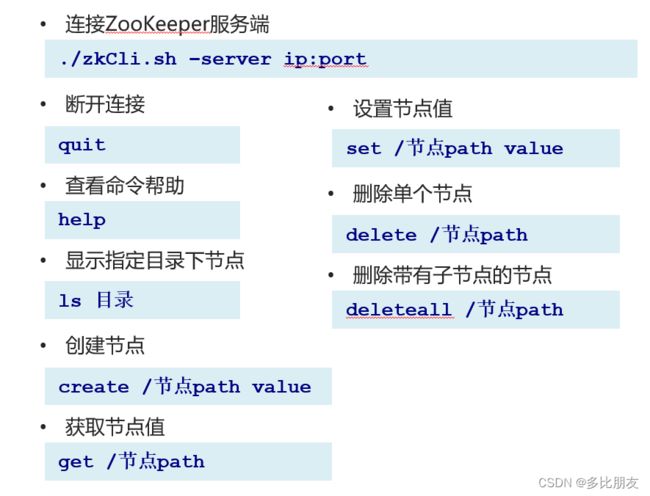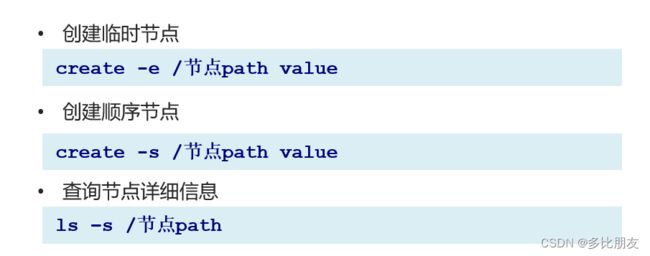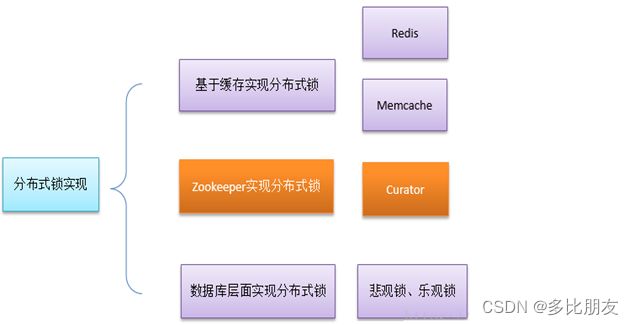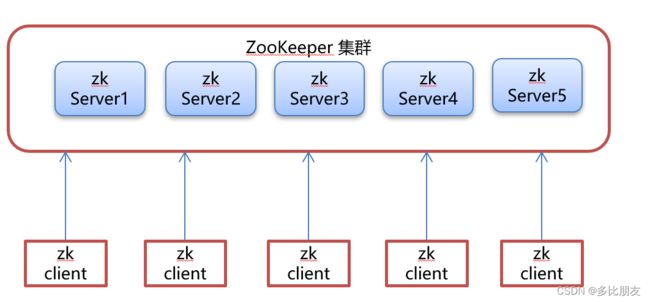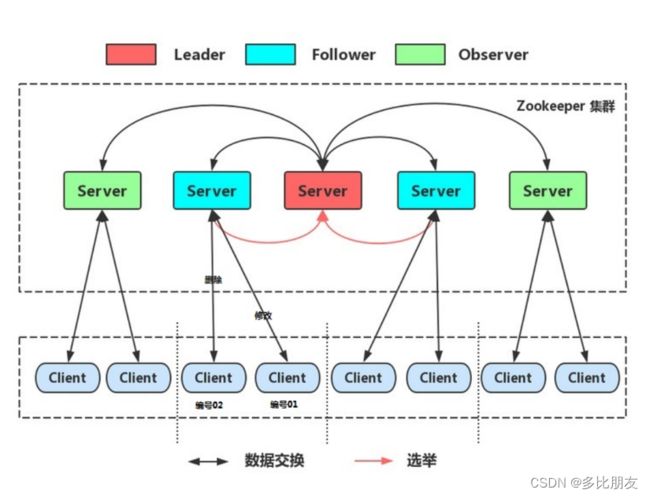zookeeper
目录
zookeeper
1.1 下载安装
1、环境准备
2、上传
3、解压
1.2 配置启动
1、配置zoo.cfg
2、Zookeeper 服务端常用命令
3、Zookeeper 客户端常用命令
2.1 ZooKeeper提供了什么
3.1 使用Java API操作zookeeper
3.2Curator API 常用操作 - Watch事件监听
4.1 分布式锁实现
Curator实现分布式锁API
InterProcessSemaphoreMutex(分布式排它锁,非可重入锁):
InterProcessMutex(分布式可重入排它锁):
InterProcessReadWriteLock(分布式读写锁):
InterProcessMultiLock(多锁容器):
InterProcessSemaphoreV2(共享信号量):
ZooKeeper分布式锁原理
布式锁案例 – 模拟12306售票
5.1 ZooKeeper 集群搭建
Leader选举:
Zookeeper 集群角色
zookeeper
是一个分布式服务框架,是Apache Hadoop 的一个子项目,它主要是用来解决分布式应用中经常遇到的一些数据管理问题,如:统一命名服务、状态同步服务、集群管理、分布式应用配置项的管理等。简单来说zookeeper=文件系统+监听通知机制。
1.1 下载安装
1、环境准备
ZooKeeper服务器是用Java创建的,它运行在JVM之上。需要安装JDK 7或更高版本。
2、上传
将下载的ZooKeeper放到/opt/ZooKeeper目录下
#上传zookeeper alt+p
put f:/setup/apache-zookeeper-3.5.6-bin.tar.gz
#打开 opt目录
cd /opt
#创建zooKeeper目录
mkdir zooKeeper
#将zookeeper安装包移动到 /opt/zooKeeper
mv apache-zookeeper-3.5.6-bin.tar.gz /opt/zookeeper/
3、解压
将tar包解压到/opt/zookeeper目录下
tar -zxvf apache-ZooKeeper-3.5.6-bin.tar.gz
1.2 配置启动
1、配置zoo.cfg
进入到conf目录拷贝一个zoo_sample.cfg并完成配置
#进入到conf目录
cd /opt/zooKeeper/apache-zooKeeper-3.5.6-bin/conf/
#拷贝
cp zoo_sample.cfg zoo.cfg
修改zoo.cfg
#打开目录
cd /opt/zooKeeper/
#创建zooKeeper存储目录
mkdir zkdata
#修改zoo.cfg
vim /opt/zooKeeper/apache-zooKeeper-3.5.6-bin/conf/zoo.cfg
配置说明
- tickTime:这个时间是作为 Zookeeper 服务器之间或客户端与服务器之间维持心跳的时间间隔,也就是每个 tickTime 时间就会发送一个心跳。
- initLimit:这个配置项是用来配置 Zookeeper 接受客户端(这里所说的客户端不是用户连接 Zookeeper 服务器的客户端,而是 Zookeeper 服务器集群中连接到 Leader 的 Follower 服务器)初始化连接时最长能忍受多少个心跳时间间隔数。当已经超过 10个心跳的时间(也就是 tickTime)长度后 Zookeeper 服务器还没有收到客户端的返回信息,那么表明这个客户端连接失败。总的时间长度就是 10*2000=20 秒
- syncLimit:这个配置项标识 Leader 与 Follower 之间发送消息,请求和应答时间长度,最长不能超过多少个 tickTime 的时间长度,总的时间长度就是 5*2000=10秒
- dataDir:顾名思义就是 Zookeeper 保存数据的目录,默认情况下,Zookeeper 将写数据的日志文件也保存在这个目录里。
- clientPort:这个端口就是客户端连接 Zookeeper 服务器的端口,Zookeeper 会监听这个端口,接受客户端的访问请求。
- server.A=B:C:D:其中 A 是一个数字,表示这个是第几号服务器;B 是这个服务器的 ip 地址;C 表示的是这个服务器与集群中的 Leader 服务器交换信息的端口;D 表示的是万一集群中的 Leader 服务器挂了,需要一个端口来重新进行选举,选出一个新的 Leader,而这个端口就是用来执行选举时服务器相互通信的端口。如果是伪集群的配置方式,由于 B 都是一样,所以不同的 Zookeeper 实例通信端口号不能一样,所以要给它们分配不同的端口号。
2、Zookeeper 服务端常用命令
3、Zookeeper 客户端常用命令
节点信息
2.1 ZooKeeper提供了什么
- 文件系统
- Zookeeper是一个树形目录服务,其数据模型和Unix的文件系统目录树很类似,拥有一个层次化结构,提供一个多层级的节点命名空间(节点称为znode)。与文件系统不同的是,这些节点都可以设置关联的数据(每个节点上都会保存自己的数据和节点信息),而文件系统中只有文件节点可以存放数据而目录节点不行。Zookeeper为了保证高吞吐和低延迟,在内存中维护了这个树状的目录结构,这种特性使得Zookeeper不能用于存放大量的数据,每个节点的存放数据上限为1M。
- 通知机制
- client端会对某个znode建立一个watcher事件,当该znode发生变化时(数据改变、被删除、子目录节点增加删除)时,这些client会收到zk的通知,然后client可以根据znode变化来做出业务上的改变等。
3.1 使用Java API操作zookeeper
Curator 是 Apache ZooKeeper 的Java客户端库。
在服务器上一定要关闭防火墙 或者 对2128端口进行放行(踩过的大坑
常见的ZooKeeper Java API :
org.apache.curator
curator-framework
4.0.0
org.apache.curator
curator-recipes
4.0.0
log4j.properties
log4j.rootLogger=off,stdout
log4j.appender.stdout = org.apache.log4j.ConsoleAppender
log4j.appender.stdout.Target = System.out
log4j.appender.stdout.layout = org.apache.log4j.PatternLayout
log4j.appender.stdout.layout.ConversionPattern = [%d{yyyy-MM-dd HH/:mm/:ss}]%-5p %c(line/:%L) %x-%m%npackage com.itheima.curator;
import org.apache.curator.RetryPolicy;
import org.apache.curator.framework.CuratorFramework;
import org.apache.curator.framework.CuratorFrameworkFactory;
import org.apache.curator.framework.api.BackgroundCallback;
import org.apache.curator.framework.api.CuratorEvent;
import org.apache.curator.retry.ExponentialBackoffRetry;
import org.apache.zookeeper.CreateMode;
import org.apache.zookeeper.data.Stat;
import org.junit.jupiter.api.AfterEach;
import org.junit.jupiter.api.BeforeEach;
import org.junit.jupiter.api.Test;
import java.util.List;
public class CuratorTest {
private CuratorFramework client;
/**
* 建立连接
*/
@BeforeEach
public void testConnect() throws Exception{
/*
*
* @param connectString 连接字符串。zk server 地址和端口 "192.168.149.135:2181,192.168.149.136:2181"
* @param sessionTimeoutMs 会话超时时间 单位ms
* @param connectionTimeoutMs 连接超时时间 单位ms
* @param retryPolicy 重试策略
*/
// /* //重试策略
// RetryPolicy retryPolicy = new ExponentialBackoffRetry(3000,10);
// //1.第一种方式
// CuratorFramework client = CuratorFrameworkFactory.newClient("121.37.118.193:2181",
// 60 * 1000, 15 * 1000, retryPolicy);
//重试策略
RetryPolicy retryPolicy = new ExponentialBackoffRetry(3000, 10);
// //2.第二种方式
// //CuratorFrameworkFactory.builder();
client = CuratorFrameworkFactory.builder()
.connectString("121.37.118.193:2181")
.sessionTimeoutMs(60 * 1000)
.connectionTimeoutMs(15 * 1000)
.retryPolicy(retryPolicy)
.namespace("itheima")
.build();
//
// //开启连接
client.start();
// System.out.println(client.getConfig().toString());
}
//==============================create=============================================================================
/**
* 创建节点:create 持久 临时 顺序 数据
* 1. 基本创建 :create().forPath("")
* 2. 创建节点 带有数据:create().forPath("",data)
* 3. 设置节点的类型:create().withMode().forPath("",data)
* 4. 创建多级节点 /app1/p1 :create().creatingParentsIfNeeded().forPath("",data)
*/
@Test
public void testCreate() throws Exception {
//2. 创建节点 带有数据
//如果创建节点,没有指定数据,则默认将当前客户端的ip作为数据存储
String path = client.create().forPath("/app2", "hehe".getBytes());
System.out.println(path);
}
@Test
public void testCreate2() throws Exception {
//1. 基本创建
//如果创建节点,没有指定数据,则默认将当前客户端的ip作为数据存储
String path = client.create().forPath("/app1");
System.out.println(path);
}
@Test
public void testCreate3() throws Exception {
//3. 设置节点的类型
//默认类型:持久化
String path = client.create().withMode(CreateMode.EPHEMERAL).forPath("/app3");
System.out.println(path);
}
@Test
public void testCreate4() throws Exception {
//4. 创建多级节点 /app1/p1
//creatingParentsIfNeeded():如果父节点不存在,则创建父节点
String path = client.create().creatingParentsIfNeeded().forPath("/app4/p1");
System.out.println(path);
}
//===========================get================================================================================
/**
* 查询节点:
* 1. 查询数据:get: getData().forPath()
* 2. 查询子节点: ls: getChildren().forPath()
* 3. 查询节点状态信息:ls -s:getData().storingStatIn(状态对象).forPath()
*/
@Test
public void testGet1() throws Exception {
//1. 查询数据:get
byte[] data = client.getData().forPath("/app1");
System.out.println(new String(data));
}
@Test
public void testGet2() throws Exception {
// 2. 查询子节点: ls
List path = client.getChildren().forPath("/");
System.out.println(path);
}
@Test
public void testGet3() throws Exception {
Stat status = new Stat();
System.out.println(status);
//3. 查询节点状态信息:ls -s
client.getData().storingStatIn(status).forPath("/app1");
System.out.println(status);
}
//===========================set================================================================================
/**
* 修改数据
* 1. 基本修改数据:setData().forPath()
* 2. 根据版本修改: setData().withVersion().forPath()
* * version 是通过查询出来的。目的就是为了让其他客户端或者线程不干扰我。
*
* @throws Exception
*/
@Test
public void testSet() throws Exception {
client.setData().forPath("/app1", "itcast".getBytes());
}
@Test
public void testSetForVersion() throws Exception {
Stat status = new Stat();
//3. 查询节点状态信息:ls -s
client.getData().storingStatIn(status).forPath("/app1");
int version = status.getVersion();//查询出来的 3
System.out.println(version);
client.setData().withVersion(version).forPath("/app1", "hehe".getBytes());
}
//===========================delete================================================================================
/**
* 删除节点: delete deleteall
* 1. 删除单个节点:delete().forPath("/app1");
* 2. 删除带有子节点的节点:delete().deletingChildrenIfNeeded().forPath("/app1");
* 3. 必须成功的删除:为了防止网络抖动。本质就是重试。 client.delete().guaranteed().forPath("/app2");
* 4. 回调:inBackground
* @throws Exception
*/
@Test
public void testDelete() throws Exception {
// 1. 删除单个节点
client.delete().forPath("/app1");
}
@Test
public void testDelete2() throws Exception {
//2. 删除带有子节点的节点
client.delete().deletingChildrenIfNeeded().forPath("/app4");
}
@Test
public void testDelete3() throws Exception {
//3. 必须成功的删除
client.delete().guaranteed().forPath("/app2");
}
@Test
public void testDelete4() throws Exception {
//4. 回调
client.delete().guaranteed().inBackground(new BackgroundCallback(){
@Override
public void processResult(CuratorFramework client, CuratorEvent event) throws Exception {
System.out.println("我被删除了~");
System.out.println(event);
}
}).forPath("/app1");
}
@AfterEach
public void close() {
if (client != null) {
client.close();
}
System.out.println("22222");
}
}
3.2Curator API 常用操作 - Watch事件监听
- ZooKeeper 允许用户在指定节点上注册一些Watcher,并且在一些特定事件触发的时候,ZooKeeper 服务端会将事件通知到感兴趣的客户端上去,该机制是 ZooKeeper 实现分布式协调服务的重要特性。
- ZooKeeper 中引入了Watcher机制来实现了发布/订阅功能能,能够让多个订阅者同时监听某一个对象,当一个对象自身状态变化时,会通知所有订阅者。
- ZooKeeper 原生支持通过注册Watcher来进行事件监听,但是其使用并不是特别方便
- 需要开发人员自己反复注册Watcher,比较繁琐。
- Curator引入了 Cache 来实现对 ZooKeeper 服务端事件的监听。
- ZooKeeper提供了三种Watcher:
- NodeCache : 只是监听某一个特定的节点
- PathChildrenCache : 监控一个ZNode的子节点.
- TreeCache : 可以监控整个树上的所有节点,类似于PathChildrenCache和NodeCache的组合
/**
* 演示 NodeCache:给指定一个节点注册监听器
*/
@Test
public void testNodeCache() throws Exception {
//1. 创建NodeCache对象
final NodeCache nodeCache = new NodeCache(client,"/app1");
//2. 注册监听
nodeCache.getListenable().addListener(new NodeCacheListener() {
@Override
public void nodeChanged() throws Exception {
System.out.println("节点变化了~");
//获取修改节点后的数据
byte[] data = nodeCache.getCurrentData().getData();
System.out.println(new String(data));
}
});
//3. 开启监听.如果设置为true,则开启监听是,加载缓冲数据
nodeCache.start(true);
while (true){
}
}
/**
* 演示 PathChildrenCache:监听某个节点的所有子节点们
*/
@Test
public void testPathChildrenCache() throws Exception {
//1.创建监听对象
PathChildrenCache pathChildrenCache = new PathChildrenCache(client,"/app2",true);
//2. 绑定监听器
pathChildrenCache.getListenable().addListener(new PathChildrenCacheListener() {
@Override
public void childEvent(CuratorFramework client, PathChildrenCacheEvent event) throws Exception {
System.out.println("子节点变化了~");
System.out.println(event);
//监听子节点的数据变更,并且拿到变更后的数据
//1.获取类型
PathChildrenCacheEvent.Type type = event.getType();
//2.判断类型是否是update
if(type.equals(PathChildrenCacheEvent.Type.CHILD_UPDATED)){
System.out.println("数据变了!!!");
byte[] data = event.getData().getData();
System.out.println(new String(data));
}
}
});
//3. 开启
pathChildrenCache.start();
while (true){
}
}
/**
* 演示 TreeCache:监听某个节点自己和所有子节点们
*/
@Test
public void testTreeCache() throws Exception {
//1. 创建监听器
TreeCache treeCache = new TreeCache(client,"/app2");
//2. 注册监听
treeCache.getListenable().addListener(new TreeCacheListener() {
@Override
public void childEvent(CuratorFramework client, TreeCacheEvent event) throws Exception {
System.out.println("节点变化了");
System.out.println(event);
}
});
//3. 开启
treeCache.start();
while (true){
}
}
4.1 分布式锁实现
Curator实现分布式锁API
InterProcessSemaphoreMutex(分布式排它锁,非可重入锁):
这是一种排他锁,用于确保在分布式环境中只有一个线程能够获取锁并访问共享资源。与Java中的普通锁不同,这种锁不支持可重入,意味着一个线程在持有锁的情况下不能再次获取相同的锁。
- 场景:适用于需要保护临界区,但不支持同一个线程多次获取锁的情况。
- 类比:一个厕所的门锁,只有一个人可以进去,进去后锁上,其他人必须等待。
InterProcessSemaphoreMutexlock = new InterProcessSemaphoreMutex(client, "/lockPath");
try {
lock.acquire();
// 你的业务逻辑
} catch (Exception e) {
e.printStackTrace();
} finally {
lock.release();
}
jInterProcessMutex(分布式可重入排它锁):
类似于InterProcessSemaphoreMutex,这也是一种排他锁,但与之不同的是,它支持可重入。这意味着一个线程在获取锁后,仍然可以再次获取同一个锁,而不会发生死锁。
- 场景:适用于需要保护临界区,支持同一个线程多次获取锁的情况。
- 类比:家里的房间门锁,你可以进出多次,只要你拥有钥匙。
InterProcessMutex lock = new InterProcessMutex(client, "/lockPath");
try {
lock.acquire();
// 你的业务逻辑
lock.acquire(); // 可重入
// 更多业务逻辑
} catch (Exception e) {
e.printStackTrace();
} finally {
lock.release();
lock.release(); // 可重入
}
InterProcessReadWriteLock(分布式读写锁):
这种锁允许多个线程同时访问共享资源,但在某个线程获取写锁(排它锁)时,其他线程不能同时获取写锁或读锁。这样可以实现读写分离,提高并发性能。
- 场景:适用于读多写少的场景,允许多个线程同时读取,但只允许一个线程写入。
- 类比:图书馆的阅览区,多人可以同时阅读书籍,但只有一个人可以写下笔记。
InterProcessReadWriteLock readWriteLock = new InterProcessReadWriteLock(client, "/lockPath");
InterProcessMutex readLock = readWriteLock.readLock();
InterProcessMutex writeLock = readWriteLock.writeLock();
try {
readLock.acquire(); // 获取读锁
// 读操作
} catch (Exception e) {
e.printStackTrace();j
} finally {
readLock.release();
}
try {
writeLock.acquire(); // 获取写锁
// 写操作
} catch (Exception e) {
e.printStackTrace();
} finally {
writeLock.release();
}
InterProcessMultiLock(多锁容器):
InterProcessMultiLock允许将多个锁作为单个实体进行管理。这对于需要同时获取多个锁的情况很有用,例如跨多个资源进行操作时,可以避免死锁问题。
- 场景:适用于需要同时操作多个资源,确保获取所有资源的顺序,避免死锁。
- 类比:假设你需要锁住两个门才能进入一个房间,你希望确保每次都是先锁门A再锁门B,避免锁的顺序问题。
- 类比:假设你正在编写一个在线多人游戏,游戏数据分散在多个服务器上。每个服务器都有一个锁,用于管理该服务器上的游戏数据。当你需要更新玩家数据时,必须同时获取多个服务器上的锁,以确保数据一致性。
InterProcessMutex lock1 = new InterProcessMutex(client, "/lockPath1");
InterProcessMutex lock2 = new InterProcessMutex(client, "/lockPath2");
List locks = Arrays.asList(lock1, lock2);
InterProcessMultiLock multiLock = new InterProcessMultiLock(locks);
try {
multiLock.acquire();
// 你的业务逻辑
} catch (Exception e) {
e.printStackTrace();
} finally {
multiLock.release();
}
InterProcessSemaphoreV2(共享信号量):
共享信号量允许多个线程在同一时刻共享资源,但限制了同时访问资源的线程数量。与经典信号量类似,这可以用于控制资源的并发访问数量。
- 场景:适用于控制并发访问的数量,例如资源池。
- 类比:在一个游泳池里,你只允许同时有一定数量的人,当有人离开池子时,下一个人可以进入。
int maxLeases = 10; // 最大许可数
String semaphorePath = "/semaphorePath";
InterProcessSemaphoreV2 semaphore = new InterProcessSemaphoreV2(client, semaphorePath, maxLeases);
SemaphoreLease lease = semaphore.acquire();
try {
// 你的业务逻辑
} catch (Exception e) {
e.printStackTrace();
} finally {
semaphore.returnLease(lease);
}
- InterProcessSemaphoreMutex:分布式排它锁(非可重入锁)
- InterProcessMutex:分布式可重入排它锁
- InterProcessReadWriteLock:分布式读写锁
- InterProcessMultiLock:将多个锁作为单个实体管理的容器
- InterProcessSemaphoreV2:共享信号量
跨机器的进程之间的数据同步问题——这就是分布式锁。
ZooKeeper分布式锁原理
布式锁案例 – 模拟12306售票
public class LockTest {
public static void main(String[] args) {
Ticket12306 ticket12306 = new Ticket12306();
//创建客户端
Thread t1 = new Thread(ticket12306,"携程");
Thread t2 = new Thread(ticket12306,"飞猪");
t1.start();
t2.start();
}
}
public class Ticket12306 implements Runnable{
private int tickets = 10;//数据库的票数
private InterProcessMutex lock ;
public Ticket12306(){
//重试策略
RetryPolicy retryPolicy = new ExponentialBackoffRetry(3000, 10);
//2.第二种方式
//CuratorFrameworkFactory.builder();
CuratorFramework client = CuratorFrameworkFactory.builder()
.connectString("121.37.118.193:2181")
.sessionTimeoutMs(60 * 1000)
.connectionTimeoutMs(15 * 1000)
.retryPolicy(retryPolicy)
.build();
//开启连接
client.start();
lock = new InterProcessMutex(client,"/lock");
}
@Override
public void run() {
while(true){
//获取锁
try {
lock.acquire(3, TimeUnit.SECONDS);
if(tickets > 0){
System.out.println(Thread.currentThread()+":"+tickets);
Thread.sleep(100);
tickets--;
}
} catch (Exception e) {
e.printStackTrace();
}finally {
//释放锁
try {
lock.release();
} catch (Exception e) {
e.printStackTrace();
}
}
}
}
}5.1 ZooKeeper 集群搭建
Leader选举:
比如有三台服务器,编号分别是1,2,3。编号越大在选择算法中的权重越大。
服务器中存放的最大数据ID.值越大说明数据 越新,在选举算法中数据越新权重越大。
Zookeeper 集群角色
在ZooKeeper集群服中务中有三个角色:
1. 处理事务请求
2. 集群内部各服务器的调度者
1. 处理客户端非事务请求,转发事务请求给Leader服务器
2. 参与Leader选举投票
1. 处理客户端非事务请求,转发事务请求给Leader服务器
